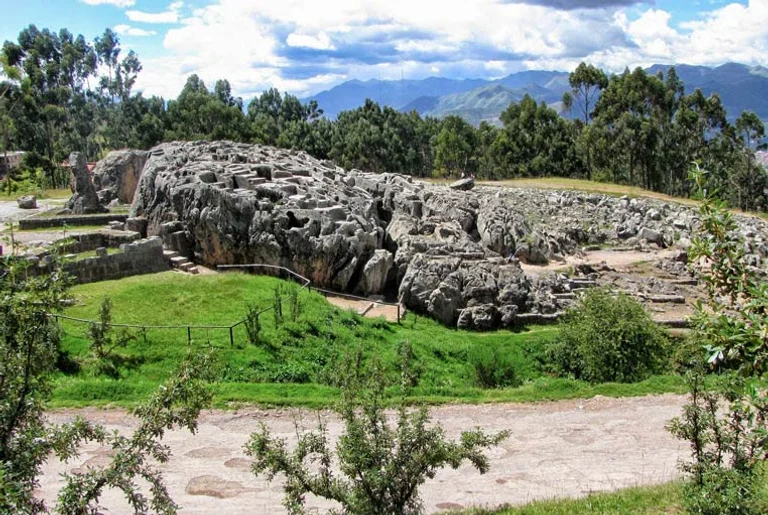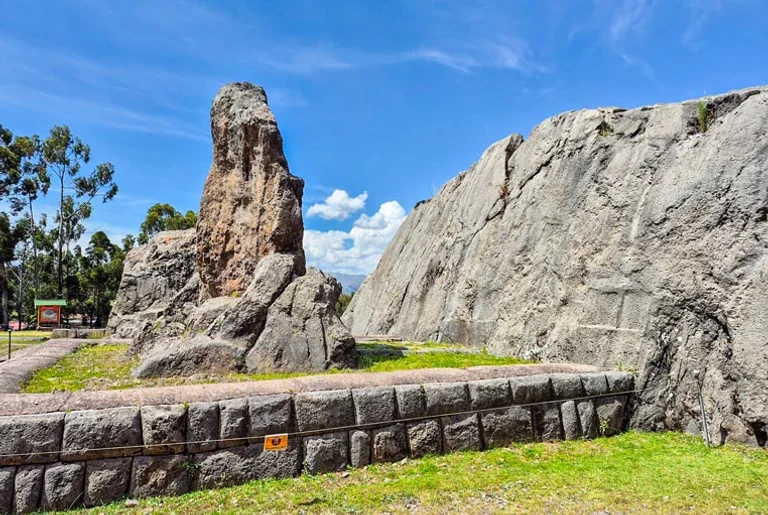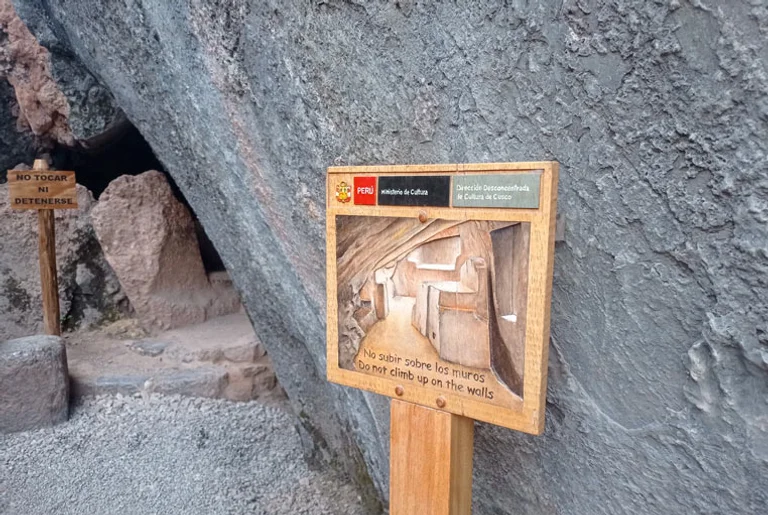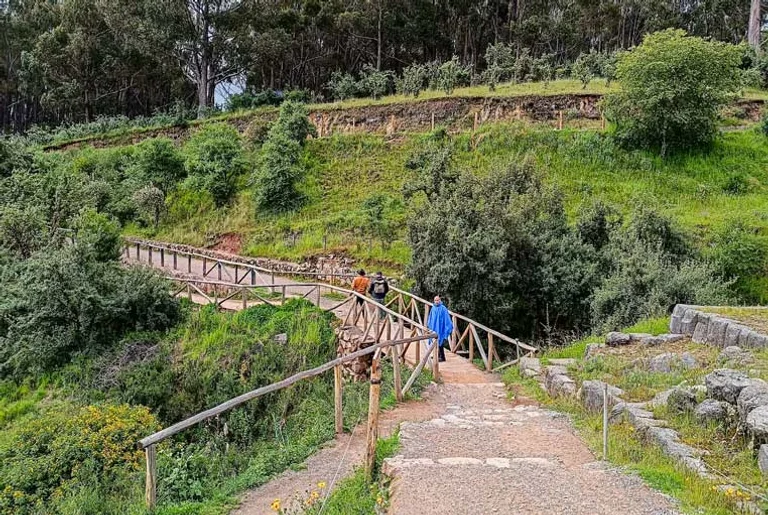
July 15, 2025
Going to Cusco? Here’s what you need to know about Qenqo.
Qenqo is one of the archaeological sites included in many Cusco tours, but it’s not always easy to find clear information about visiting it. How do I get there? How long does the tour take? Is it included in the Tourist Ticket? In this blog, we’ll tell you everything you need to plan your visit without complications.
General information
How to get to Qenqo from Cusco?
To reach Qenqo from Cusco’s historic center, you can take a taxi or a tourist bus, as the site is located about 4 km northeast, just a 10-minute drive away. It’s also possible to walk from Sacsayhuamán, as the two sites are very close to each other.
Take note! Many visitors include Qenqo as part of their Cusco City Tour, which is usually done by bus and includes stops at other places like Puca Pucara, Tambomachay, and Sacsayhuamán.
Visiting hours at Qenqo
The Qenqo archaeological site is open every day of the year, including holidays, from 7:00 a.m. to 5:30 p.m. It is recommended to visit in the morning to make the most of the daylight.
Although entry is free with the Tourist Ticket Access is controlled to maintain the site’s preservation. If you plan to hire a tour guide, remember to book their services in advance, as finding one available on-site will be impossible.
How long does the Qenqo tour last?
The tour of Qenqo typically lasts between 30 and 45 minutes, depending on the visitor’s interest and the availability of a guide. The site is not very large, but it has underground passages and rock-carved structures worth exploring, such as the ceremonial altar located inside a large rock, where rituals were performed in Inca times.
Many tourists combine Qenqo with visits to other nearby sites, so the total tour time can extend to several hours if you complete the entire circuit. For those on an organized city tour, the stopover time is usually short, so if you want to explore at a leisurely pace, it’s best to go on your own or with a small group.

Note: To enter this archaeological site, it is essential to have a Cusco Tourist Ticket, either partial or full. Keep in mind that this ticket also includes access to other tourist destinations in Cusco.
History and meaning
What was the use of Qenqo in the Inca era?
During the Inca period, Qenqo was a ceremonial center dedicated to religious rituals and possibly mummification. Its main structure, carved from a massive rock, features passages, canals, and underground chambers that would have been used for offerings and sacrifices.
It is believed to have been a site reserved for the Inca elite and priests, where ceremonies related to life, death, and nature worship were performed. Its astronomical orientation and the arrangement of its elements indicate that Qenqo was not an everyday space, but rather a sacred place with a specific ceremonial purpose.
Meaning of the name «Qenqo»
The name “Qenqo” comes from the Quechua “q’inqu,” meaning “labyrinth” or “zigzag,” in reference to the channels carved into the stone that wind in curved shapes. These shapes are also seen in the site’s internal passages, which resemble narrow, labyrinthine tunnels through which water or perhaps blood flowed during rituals.
The name reflects not only the site’s physical appearance but also the enigmatic character attributed to it by the Incas. The irregular shapes of the relief and its unconventional design distinguish it from other, more symmetrical and structured ceremonial centers, reinforcing its mystery and symbolism.
Theories about the rituals performed in Qenqo
There are several theories about the rituals that took place at Qenqo. One of the most widely accepted suggests that it was a center for sacrifices, possibly involving llamas or other animals, whose remains were offered to the gods. Channels carved into the rock would have served to convey the blood of these sacrifices as part of the ritual.
Another theory suggests that Qenqo was used for mummification rituals, or the preparation of important bodies before burial, and that the precisely carved altar inside the large rock would have served as a ritual table for these acts. Although there is no conclusive evidence, archaeological studies agree that the site was used strictly for ceremonial purposes.
The importance of Qenqo in the Inca calendar
Qenqo had an astronomical function related to the Inca calendar, especially during the solstices. Some researchers believe that certain shadows and alignments within the enclosure marked important dates, helping priests follow the agricultural cycle and establish rituals at key times of the year.
This type of astronomical observation was common at several Inca sacred sites, as the calendar was deeply connected to the phases of the sun, moon, and seasons. Qenqo would have been a strategic point for these events, serving not only as a ceremonial altar but also as a symbolic observatory of sacred time.
What role did Qenqo play in religious ceremonies?
Qenqo played an important role in Inca religious ceremonies, especially those related to death, rebirth, and the cycles of nature. It was a place for offerings and rituals in honor of the gods, particularly Pachamama and possibly Inti. The dark, enclosed space of its passageways helped create an atmosphere of contemplation and respect.
Furthermore, the site’s layout and its location near Sacsayhuamán suggest that Qenqo was part of a network of sacred sites used by Inca priests. Its spiritual value lay in serving as a space of transition between the earthly and the divine, a point where humans communicated directly with the forces of nature through carefully prepared ceremonies.

Travel Tips
What to bring to visit Qenqo?
To visit Qenqo, wear comfortable clothing and sneakers with good grip, as the terrain is uneven in some areas. A light jacket is useful if you go early or during the rainy season. It is also recommended to bring a hat, sunglasses, and sunscreen due to the strong sun exposure in Cusco.
Don’t forget to bring a reusable water bottle and a light snack if you’re doing the entire tour of the nearby sites. If you’re carrying a backpack, make sure it’s small and light, as the Qenqo hike isn’t long, but it does involve walking among stones and through narrow passages.
Best time of day to tour Qenqo
The best time to visit Qenqo is in the morning, between 7 and 10 a.m., when the weather is cooler and natural light allows you to better see the details carved into the rocks, ideal if you are interested in taking photos or calmly appreciating the structures.
Another option is to go between 1 and 3 p.m. , when many tour groups have already passed by. Although the weather can become hotter or more changeable at that time, avoid going close to the 5:30 p.m. closing time, as you won’t have enough time to explore it leisurely.
Is it advisable to go with a tour guide?
Yes, visiting Qenqo with a tour guide is highly recommended if you want to understand the true significance of the site. At first glance, many of the structures may appear to be mere carved stones, but a guide can explain their function and connections to the Inca worldview.
Additionally, a guide can help you spot details you might miss if you go on your own. Many tours, such as City Tour Cusco, include professional guides, although you can also hire one independently in the historic center.
Tips for combining Qenqo with Sacsayhuamán
Combining Qenqo with Sacsayhuamán is an excellent idea, as both sites are very close. Ideally, start at Sacsayhuamán, which is larger, and then walk or take a short transfer to Qenqo. The walk takes about 10 to 15 minutes and is a pleasant way to enjoy the Andean scenery.
If you plan to visit multiple sites in the same day, such as Puca Pucara and Tambomachay, it’s best to organize your trip in that order, from farthest to closest. You can also do this as part of a city tour or hire a taxi to wait for you at each stop. Bring water, snacks, and your valid Tourist Ticket to avoid wasting time at the entrances.

Frequently Asked Questions
Where exactly is Qenqo?
Qenqo is located on the outskirts of Cusco, approximately 4 km southwest of the historic center, in the Cusco Region of Peru.
What does the word Qenqo mean?
The word “Qenqo” or “Qenko” comes from Quechua and means “labyrinth” or “zigzag,” referring to the underground structures and galleries at the site.
What functions did Qenqo have for the Incas?
Qenqo was a ceremonial site used for religious rituals, especially offerings and sacrifices. Its underground galleries and carved altars suggest it was an important site for fertility cults and the worship of Mother Earth (Pachamama).
Is Qenqo included in the Cusco Tourist Ticket?
Yes, Qenqo is included in the Cusco Comprehensive Tourist Ticket, which allows you to visit several important archaeological and cultural sites in the region.
What is the difference between Qenqo Grande and Qenqo Chico?
Qenqo Grande is the main site, known for its underground galleries, carved altars, and ritual structures. Qenqo Chico is a smaller, lesser-known area with fewer structures, located near the main site.
Is Qenqo close to Sacsayhuamán?
Yes, Qenqo is very close to Sacsayhuamán, just a few minutes away by car or on foot. Both are part of the Cusco archaeological circuit.
Can you visit Qenqo without a tour?
Yes, you can visit Qenqo on your own without booking a tour, especially if you have the Cusco Tourist Ticket or purchase direct admission.
How long does it take to travel around Qenqo?
The Qenqo tour takes approximately 45 minutes to 1 hour, depending on the visitor’s interest in exploring and taking photographs.
Is it dangerous to visit Qenqo during the rainy season?
It’s not dangerous, but it’s advisable to be cautious as the trails can be slippery and some areas muddy. It’s best to wear appropriate footwear and avoid periods of heavy rain.